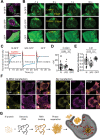SARS-CoV-2 nucleocapsid protein forms condensates with viral genomic RNA
- PMID: 34634033
- PMCID: PMC8553124
- DOI: 10.1371/journal.pbio.3001425
SARS-CoV-2 nucleocapsid protein forms condensates with viral genomic RNA
Abstract
The Severe Acute Respiratory Syndrome Coronavirus 2 (SARS-CoV-2) infection causes Coronavirus Disease 2019 (COVID-19), a pandemic that seriously threatens global health. SARS-CoV-2 propagates by packaging its RNA genome into membrane enclosures in host cells. The packaging of the viral genome into the nascent virion is mediated by the nucleocapsid (N) protein, but the underlying mechanism remains unclear. Here, we show that the N protein forms biomolecular condensates with viral genomic RNA both in vitro and in mammalian cells. While the N protein forms spherical assemblies with homopolymeric RNA substrates that do not form base pairing interactions, it forms asymmetric condensates with viral RNA strands. Cross-linking mass spectrometry (CLMS) identified a region that drives interactions between N proteins in condensates, and deletion of this region disrupts phase separation. We also identified small molecules that alter the size and shape of N protein condensates and inhibit the proliferation of SARS-CoV-2 in infected cells. These results suggest that the N protein may utilize biomolecular condensation to package the SARS-CoV-2 RNA genome into a viral particle.
Conflict of interest statement
The authors have declared that no competing interests exist.
Figures






Update of
-
SARS-CoV-2 nucleocapsid protein forms condensates with viral genomic RNA.bioRxiv [Preprint]. 2021 Mar 29:2020.09.14.295824. doi: 10.1101/2020.09.14.295824. bioRxiv. 2021. Update in: PLoS Biol. 2021 Oct 11;19(10):e3001425. doi: 10.1371/journal.pbio.3001425. PMID: 32995779 Free PMC article. Updated. Preprint.
Similar articles
-
SARS-CoV-2 nucleocapsid protein forms condensates with viral genomic RNA.bioRxiv [Preprint]. 2021 Mar 29:2020.09.14.295824. doi: 10.1101/2020.09.14.295824. bioRxiv. 2021. Update in: PLoS Biol. 2021 Oct 11;19(10):e3001425. doi: 10.1371/journal.pbio.3001425. PMID: 32995779 Free PMC article. Updated. Preprint.
-
Genomic RNA Elements Drive Phase Separation of the SARS-CoV-2 Nucleocapsid.Mol Cell. 2020 Dec 17;80(6):1078-1091.e6. doi: 10.1016/j.molcel.2020.11.041. Epub 2020 Nov 27. Mol Cell. 2020. PMID: 33290746 Free PMC article.
-
The SARS-CoV-2 nucleocapsid phosphoprotein forms mutually exclusive condensates with RNA and the membrane-associated M protein.Nat Commun. 2021 Jan 21;12(1):502. doi: 10.1038/s41467-020-20768-y. Nat Commun. 2021. PMID: 33479198 Free PMC article.
-
Structural basis for the participation of the SARS-CoV-2 nucleocapsid protein in the template switch mechanism and genomic RNA reorganization.J Biol Chem. 2024 Nov;300(11):107834. doi: 10.1016/j.jbc.2024.107834. Epub 2024 Sep 27. J Biol Chem. 2024. PMID: 39343000 Free PMC article. Review.
-
Properties of Coronavirus and SARS-CoV-2.Malays J Pathol. 2020 Apr;42(1):3-11. Malays J Pathol. 2020. PMID: 32342926 Review.
Cited by
-
The intrinsically disordered SARS-CoV-2 nucleoprotein in dynamic complex with its viral partner nsp3a.Sci Adv. 2022 Jan 21;8(3):eabm4034. doi: 10.1126/sciadv.abm4034. Epub 2022 Jan 19. Sci Adv. 2022. PMID: 35044811 Free PMC article.
-
SARS-CoV-2 nucleocapsid protein binds host mRNAs and attenuates stress granules to impair host stress response.iScience. 2022 Jan 21;25(1):103562. doi: 10.1016/j.isci.2021.103562. Epub 2021 Dec 4. iScience. 2022. PMID: 34901782 Free PMC article.
-
Unraveling the assembly mechanism of SADS-CoV virus nucleocapsid protein: insights from RNA binding, dimerization, and epitope diversity profiling.J Virol. 2024 Aug 20;98(8):e0092624. doi: 10.1128/jvi.00926-24. Epub 2024 Jul 31. J Virol. 2024. PMID: 39082816 Free PMC article.
-
TRIM28-mediated nucleocapsid protein SUMOylation enhances SARS-CoV-2 virulence.Nat Commun. 2024 Jan 4;15(1):244. doi: 10.1038/s41467-023-44502-6. Nat Commun. 2024. PMID: 38172120 Free PMC article.
-
A specific phosphorylation-dependent conformational switch in SARS-CoV-2 nucleocapsid protein inhibits RNA binding.Sci Adv. 2024 Aug 2;10(31):eaax2323. doi: 10.1126/sciadv.aax2323. Epub 2024 Aug 2. Sci Adv. 2024. PMID: 39093972 Free PMC article.
References
Publication types
MeSH terms
Substances
Grants and funding
LinkOut - more resources
Full Text Sources
Medical
Research Materials
Miscellaneous

